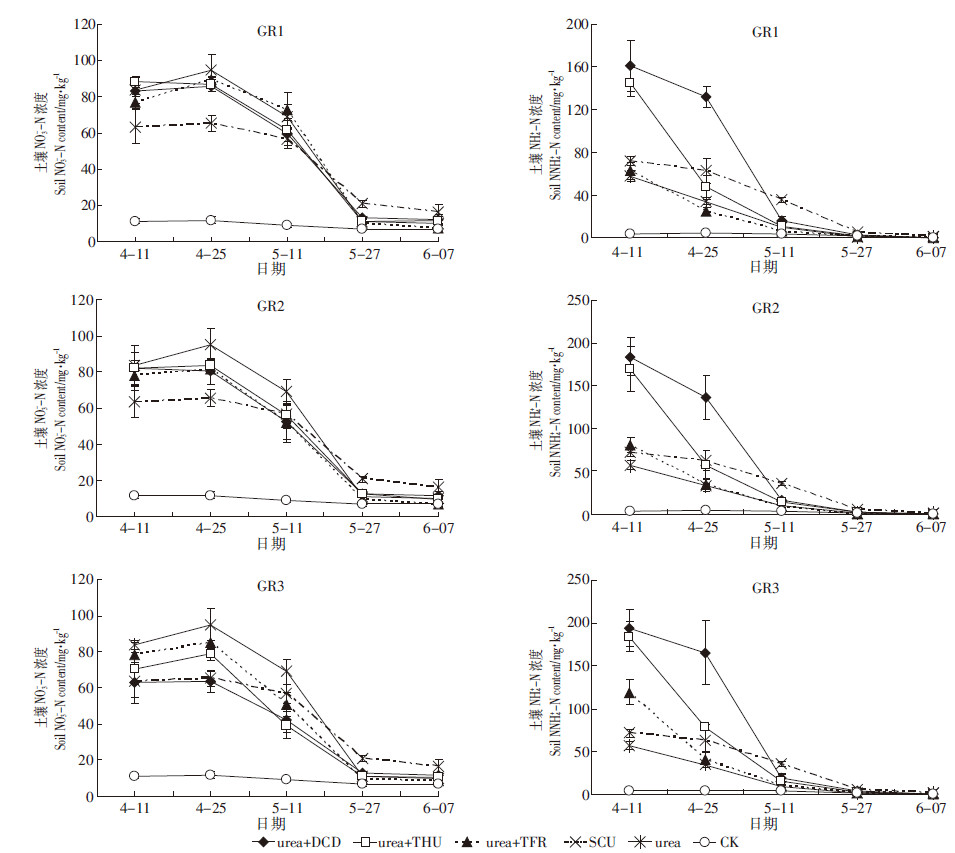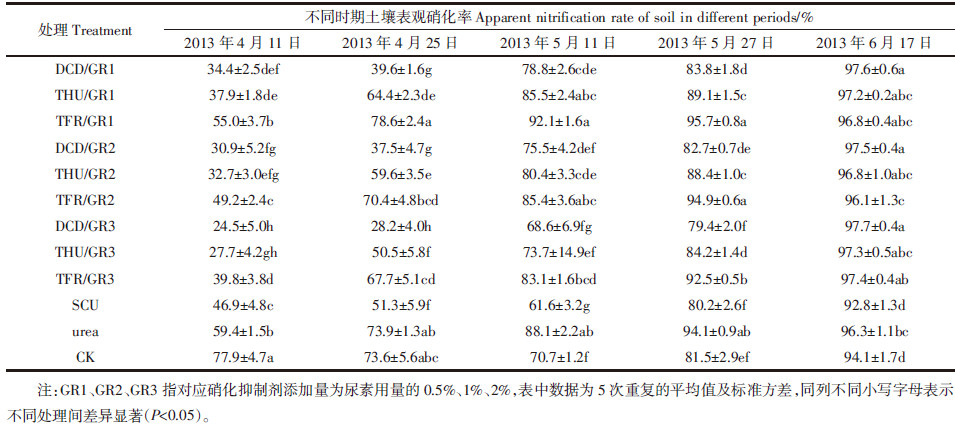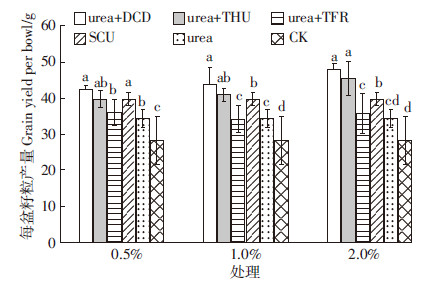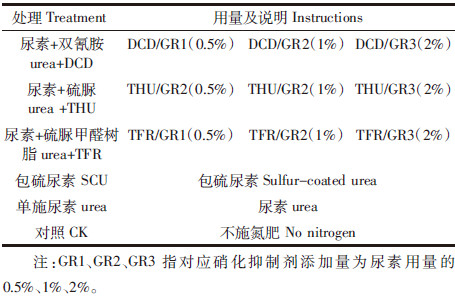文章信息
- 李永强, 王雅楣, 杨越超, 贾继文, 解璐晗, 姚瑶, 焦树英
- LI Yong-qiang, WANG Ya-mei, YANG Yue-chao, JIA Ji-wen, XIE Lu-han, YAO Yao, JIAO Shu-ying
- 几种硝化抑制剂和包硫尿素(SCU)对土壤N素形态和小麦产量的影响
- Effects of Nitrification Inhibitors and Sulphur Coated Urea(SCU) on Different Nitrogen Sources and Wheat Yield
- 农业资源与环境学报, 2016, 33(3): 230-237
- Journal of Agricultural Resources and Environment, 2016, 33(3): 230-237
- http://dx.doi.org/10.13254/j.jare.2016.0031
-
文章历史
- 收稿日期: 2016-01-22
2. 内蒙古农业大学生态环境学院, 内蒙古 呼和浩特 010018
2. College of Ecological and Environmental Sciences, Inner Mongolia Agricultural University, Hohhot 010018, China
中国是世界氮肥生产和消费的第一大国[1],在过去几十年间,增施氮肥对粮食增产和社会稳定起到十分重要的作用,得到国内外的高度认可[2, 3]。在我国的农业肥料结构中,氮肥的施用占化肥总施用量的61.2%,而以尿素为主的酰胺态氮肥施用量占到氮肥总量的一半以上[4]。高氮素投入的农业生产方式带来许多环境问题:氨挥发、氮淋溶和N2O等形式的氮损失导致水体富营养化和气候变暖[4, 5, 6];施肥产生的活性氮向大气排放,由此产生的气溶胶/细颗粒物(如PM2.5)是导致空气质量下降或大气污染的重要原因[2]。1980—2010年间,中国人为源活性氮产生量增加了近3倍,其中主要增长来自于化肥和工业用氮(从1 140×104 t增加到3 710×104 t)[7]。1998—2013年,我国小麦单位面积氮肥施用量增长接近200%,但单产水平却只提升了50%,作物氮素利用率远低于世界平均水平[2]。2015年农业部推出《到2020年化肥使用量零增长行动方案》,目的就是从技术和政策层面对肥料使用进行干预,在保证食物供给的同时,如何实现氮肥减排是当前中国解决农业环境问题和农业可持续发展的焦点问题。
尿素进入土壤中,首先在脲酶作用下水解为氨,在短时间内氨在土壤中积聚,在一定条件下部分以气态形式挥发损失;同时氨在微生物作用下被氧化成硝态氮,硝态氮易被淋失或发生硝化作用以温室气体的形式散失[8]。朱兆良[1]对我国农田化肥氮的去向进行了初步估计,认为作物吸收35%、氨挥发11%、表观硝化-反硝化34%、淋洗损失2%、径流损失5%、以及未知部分13%。尽管这一估计有很大的不确定性,但总的来看,氨挥发和硝化-反硝化,是造成氮素损失的主要途径。使用缓控释肥,被认为是解决农田N素污染的有效方法,并已经显示其效果和很好的应用前景[8, 9, 10]。缓控释肥包括尿素改性及类似物、化学合成缓释肥、包膜肥料等类型,其中包膜肥料占到缓控释肥总量的50%以上[11]。但包膜材料长期施入土壤,造成土壤污染或影响土壤团粒结构的风险增加[12]。硝化抑制剂在适宜条件下,能有效提高铵态或酰胺态氮肥施入土中NH4+-N含量,削弱NO3--N形成,从而在一定程度上降低N的损失;人们研究开发了各种脲酶/硝化抑制剂,通过抑制尿素水解和硝化反应的限速步骤来达到提高氮肥利用率并减轻环境污染的目的[10],氮素肥料混合硝化抑制剂等也被认为是有效的缓控释肥类型。国内外学者对氢醌(HQ)、双氰胺(DCD)等抑制剂的研究表明,脲酶/硝化抑制剂不同程度减少淋溶和N2O的排放,提高作物氮素利用效率,国内外许多复合肥产品中都含有一定剂量的硫脲。新西兰林肯大学Di等[13]通过10多年的研究发现,向添加高浓度氮肥的放牧草地土壤中喷施水溶态的DCD可减少42%~83%的硝酸盐淋失,降低40%~82%的N2O总排放量,DCD对硝酸盐淋失和N2O总排放量的平均抑制率分别达61%和67%;但也有研究认为,应用DCD会增加氨挥发,造成5%~16%氮素损失[14]。抑制剂类型、土壤类型、添加浓度等因素会不同程度影响氮肥增效剂的使用效果[13, 14, 15]。为此,本文对双氰胺(DCD)、硫脲(THU)和硫脲甲醛树脂(TFR)及包硫尿素(SCU)进行综合比较,探讨不同硝化抑制剂用量和形态与包膜肥料SCU对盆栽小麦土壤氮素形态和小麦产量的影响,为今后缓控释肥的研究和筛选提供基础数据和科学依据。
1 材料与方法 1.1 试验地概况室外盆栽试验从2012年10月至2013年6月于山东农业大学试验站进行。试验地属于温带半湿润大陆性季风气候,年平均温度为12.8 ℃,试验期间平均温度为18.9 ℃。年降雨量为688 mm,65% 的降雨主要集中在6、7、8月3个月,年平均相对湿度为66%。供试土壤类型为山东农业大学南校试验站试验地棕壤,取耕作层(0~20 cm)的新鲜土壤后,去除杂草根系和较大石砾,过4 mm 筛,装盆待用。土壤有机质含量10.57 g·kg-1,全氮0.63 g·kg-1,有效磷38.24 mg·kg-1,速效钾91.53 mg·kg-1,阳离子交换量6.38 cmol·kg-1。供试作物小麦品种为济麦22(Triticum aestivum L.)。
1.2 试验设计采用尿素+双氰胺(DCD)、尿素+硫脲(THU)、尿素+硫脲甲醛树脂(TFR)、包硫尿素(SCU)、单施尿素(urea)、CK(不施氮肥),共6种处理模式。其中,DCD、THU、TFR 3个处理方式分别设置3个用量梯度,分别按照尿素施用量的0.5%、1%、2%与尿素配合施入,共计12个处理,详见表 1。
采用田间盆栽方法,盆器口径32 cm,底径 25 cm,高 32 cm。盆内装土至27 cm,每盆装土20 kg,尿素施用量按照1 g尿素·kg-1土壤施用。于2012年10月6日播种小麦,成苗后每盆保留10株长势良好、较一致的幼苗;12个处理,每个处理10次重复,共120盆。按表 1设计,20 g尿素与相应比例的不同硝化抑制剂充分混合均匀后30% 以基肥施入,70% 在拔节期前追施,混合前将尿素磨细。采用KH2PO4 作为P、K肥来源,每盆施15 g。包硫尿素的用量按尿素成分折算后确定,使N素含量与其他处理一致。KH2PO4作为基肥,与土壤充分混合后装盆,于2013年3月25日追施剩余70% 的尿素+不同增效剂混合物。
1.3 取样和测定方法在小麦拔节期2013年4月11日(追肥后17 d)、抽穗期4月25日(追肥后31 d)、开花期5月11日(追肥后47 d)、灌浆期5月27日(追肥后63 d)、成熟期6月7日(追肥后74 d)5个时期进行盆栽土壤的动态调查和取样。在盆内均匀选4个点,注意避开盆缘和根系,用直径为10 mm的土钻取土,4钻混合;每个处理10盆,第一次取样选前5盆作为重复,取样后用钻孔周边土壤回填,第二次取样选取后5盆进行取样,后面取样依次轮替,尽量减少取样对盆栽土壤干扰的影响。每次取样后,带回实验室冷藏(4 ℃)并及时进行土壤分析。
土壤NH4+-N、NO3--N:新鲜土样过2 mm筛,用0.01 mol·L-1 CaCl2 溶液浸提,水土比10:1,用全自动连续流动分析仪(Alliance公司,法国)测定浸提液中的NH4+-N、NO3--N浓度[16];土壤表观硝化率:土壤表观硝化率为土壤中 NO3--N浓度与土壤无机氮总量之比[17, 18];土壤全氮:凯氏定氮法。
1.4 数据分析采用General linear model(GLM)单变量多因素方差分析判断不同硝化抑制剂类型、不同浓度、不同采样日期土壤表观硝化率的差异显著性,若差异达显著水平(P < 0.05),则采用最小显著差数法(least significant difference,LSD)对均值进行多重比较。采用单因素方差分析(one-way-ANOVA)判断不同处理土壤NO3--N和NH4+-N含量、小麦产量的显著性。
数据整理、制图采用Excel 2003软件实现,GLM单变量多因素方差分析、one-way ANOVA 由SAS System 9.0软件完成。
2 结果与分析 2.1 对土壤NO3--N和NH4+-N浓度的影响同一时期添加抑制剂和包硫尿素处理的土壤NO3--N含量都显著低于单施尿素处理(图 1),表明不同抑制剂和SCU可以抑制土壤NH4+-N向NO3--N的氧化,降低土壤NO3--N浓度,并且随着硝化抑制剂用量越大,土壤中NO3--N浓度降低越多。

|
| 注:GR1、GR2、GR3 对应硝化抑制剂添加量为urea用量的0.5%、1%、2%,图中数据为5次重复的平均值及标准方差。 图 1 不同处理土壤NO-3-N和NH+4-N浓度动态变化 Figure 1 Dynamics of soil NO-3-N and NH+4-N contents under different treatments |
除CK外,所有处理在追肥后,随时间推移,土壤NO3--N含量在第31 d(4月25日)达到各取样时间点的峰值,然后在第63 d(5月27日)降到与CK类似水平。
抑制剂用量为0.5%时,3种硝化抑制剂之间降低土壤NO3--N的作用无显著差异(P>0.05),但3种抑制剂均使在峰值期(4月25日)的NO3--N浓度显著小于单施尿素方式(P < 0.05),DCD、THU和TFR分别使NO3--N降低了9.36%、8.62%、5.89%;但到第47 d(5月11日),只有DCD和THU显著低于尿素(P < 0.05),分别降低15.17% 和10.71%。当用量为1% 时,3种抑制剂均表现出显著的降低土壤NO3--N含量的作用,但三者间差异不显著,作用强度接近。当用量为2% 时,3种抑制剂抑制效果增强,且各处理间NO3--N浓度呈现出显著性差异(P < 0.05)。与尿素相比,当用量为2% 时,DCD、THU和TFR在第17 d(4月11日)分别使NO3--N浓度降低25.06%、15.63%和6.56%,在第31 d时分别使NO3--N浓度降低33.12%、17.24% 和10.83%。3种硝化抑制剂DCD降低NO3--N浓度最多,THU次之,TFR最少,即硝化作用强度2%DCD>2% THU>2%TFR。SCU在第17 d(4月11日)、31 d(4月25日)分别使NO3--N浓度降低了24.11%和31.23%,与同一时期2%DCD的25.06% 和33.12%接近,两者作用强度接近。SCU的NO3--N浓度在追肥后的第17 d和第31 d显著低于其他处理(P < 0.05)。
土壤NH4+-N含量变化与NO3--N含量变化规律相反,与单施尿素相比,硝化抑制剂和SCU提高了土壤NH4+-N 含量,随着抑制剂用量的增加,NH4+-N增加的越多(图 1)。除CK外,各处理NH4+-N含量都呈现随施用时间的延续逐渐降低的变化趋势;当硝化抑制剂用量为0.5% 时,DCD和THU的NH4+-N 浓度在第17、31 d显著高于尿素,且DCD>THU,二者差异显著(P < 0.05),SCU在第31、47 d显著高于尿素(P < 0.05),而TFR与尿素无差异,说明该用量的TFR未能有效提高土壤NH4+-N 浓度。第17 d各处理NH4+-N浓度排序为DCD>THU>SCU,第31 d为DCD>SCU>THU,而到第47 d,SCU的浓度显著高于DCD和THU。DCD和THU在前期NH4+-N 浓度高于SCU,而在后期低于SCU。
当硝化抑制剂用量为2% 时,DCD在第17 d出现NH4+-N浓度最大值194.2 mg·kg-1,比单施尿素高出238.33%,追肥后第31 d高394.03%。2% DCD和SCU处理提高土壤NH4+-N含量的能力最强,前者体现在增加NH4+-N的量最多,SCU虽然提高的量少,但持续时间较长,后期第47 d时SCU的NH4+-N浓度高于2%DCD,前者使浓度提高了280.65%,后者提高103.23%。2%THU增加土壤NH4+-N的能力次之,第17 d时与2%DCD无差异,但到第31 d NH4+-N浓度即大幅度降低,显著低于DCD。2%TFR仅在第17 d显著高于单施尿素,效果最弱且持续时间最短。
2.2 对土壤表观硝化率的影响添加双氰胺、硫脲、硫脲甲醛树脂处理之间的土壤表观硝化率存在显著差异(F=277.08,P < 0.001,表 2)。硝化抑制剂和SCU处理的表观硝化率均小于单施尿素处理(表 3),表明各处理有效抑制了硝化反应,且对于同一种硝化抑制剂,表观硝化率随抑制剂用量增大而显著减小。
 |
 |
3种抑制剂中,添加TFR处理抑制土壤表观硝化率作用较弱,0.5% TFR在第31~74 d(4月25日—6月7日)期间的表观硝化率与单施尿素无差异,没有体现抑制硝化的作用。各处理的表观硝化率随取样时间的延续呈现出一致的上升趋势,大多都在第74 d超过90%,而TFR的3个浓度梯度均在第63 d就超过90%。
DCD和THU在3个用量下的处理及SCU处理都能够有效地降低表观硝化率。同一时期、同一用量下,3种抑制剂的表观硝化率排序为DCD < THU < TFR,即DCD抑制硝化作用为三者中最强,THU次之,TFR最弱。在第17、31 d,2% DCD抑制作用最强,表观硝化率均为两时期最小值(24.5%和28.2%)。但到后期第47、63、74 d,SCU的表观硝化率均为最低水平(61.6%、80.2%和92.8%),表明SCU能更持续稳定地发挥抑制硝化作用。
2.3 对小麦籽粒产量的影响由图 2可知,单施尿素及其他氮素添加模式,都显著高于CK(P < 0.05),小麦产量平均提高40%以上。与单施尿素相比,尿素+DCD模式,显著提高了小麦产量,且在0.5%、1%、2%添加浓度,都达到显著水平(P < 0.05)。

|
| 图中数据为5次重复的平均值及标准方差,不同小写字母表示同一浓度下不同硝化抑制剂间差异显著(P < 0.05) 图 2 不同处理小麦籽粒产量 Figure 2 Grain yield of wheat under different treatments |
THU作用仅次于DCD,在1.0%和2.0%添加浓度,都显著高于单施尿素产量;但在0.5%添加水平,与单施尿素相比,增产作用并不显著(P>0.05)。添加TFR方式在不同添加浓度,与单施尿素相比,都没有达到显著水平(P>0.05)。SCU增产效果与THU和DCE类似,但低于添加硝化抑制剂2%浓度时的增产效果。
3 讨论 3.1 单施尿素和不施氮土壤氮转化特征试验期间,单施尿素和对照不施氮土壤的表观硝化率分别处于59.4%~96.3%之间和70.7%~94.1%之间(表 3)。只在取样的第一个时间点(追肥后第17 d),单施尿素表观硝化率低于对照土壤,在后期的采样时间点,单施尿素表观硝化率均显著高于对照土壤。对照的土壤表观硝化率与其他文献报道的不施氮土壤表观硝化率72%~99%相近[10]。尿素处理土壤在初期表观硝化率反而比对照低,可能是第一次取样时土壤NO3--N释放高峰尚未出现,而土壤此时又有较高土壤无机氮总量,导致表观硝化率反而比较低,有文献认为尿素处理的NO3--N释放高峰一般出现在20 d前后[17]。本研究尿素处理的NO3--N高峰期为追肥后第31 d,NO3--N浓度达到95 mg·kg-1,而同期的对照土壤NO3--N含量仅为12 mg·kg-1(图 1)。
3.2 硝化抑制剂不同浓度对土壤氮转化的影响许多研究证明硝化抑制剂可有效抑制NH4+-N向NO3--N的硝化,减少氮素损失[19, 20]。将硝化抑制剂与尿素配施,可以延长土壤中无机氮以NH4+-N形态存在的时间,降低土壤NO3--N浓度,推迟NO3--N浓度峰值出现的时间[20]。DCD作为一种最常见的硝化抑制剂,其作用已被许多研究证实[21, 22, 23, 24, 25]。以常用的双氰胺(DCD)为对比组,比较对应用量下硫脲THU和硫脲甲醛树脂TFR的硝化抑制作用,可以为筛选不同氮素增效提供参考。目前,关于硫脲THU作为硝化抑制剂的使用已有报道,THU首先在日本被广泛用作硝化抑制剂。有研究发现硫脲在0.1%的用量下就有抑制作用,但用量0.3%~1.0%之间差异不显著,用量1.0%~5.0%之间抑制效果随用量增加而显著加强[24, 25, 26],这一点与本试验研究结果相符,硝化抑制剂添加浓度对土壤表观硝化率有显著影响(F=64.17,P < 0.001,表 2);当抑制剂用量为1% 时,TFR的NH4+-N浓度在第17 d稍高于单施尿素,差异显著(P < 0.05),但第31 d后,与单施尿素无差异,表明TFR在该用量下能够提高土壤NH4+-N含量,但作用较弱。DCD和THU处理土壤NH4+-N含量显著高于单施尿素,且DCD显著高于THU,二者在1%用量处理下的NH4+-N浓度明显高于0.5%的用量处理。各硝化抑制剂均在2%浓度下取得最好的硝化抑制作用(表 3)。
各处理的表观硝化率随时间的推迟都呈现出一致的上升趋势,大多都在第74 d超过90%,而TFR的3个浓度梯度的处理均在第63 d就超过90%。这也表明TFR的抑制作用持续时间较短,不是理想的硝化抑制剂。
3.3 硝化抑制剂和包硫尿素抑制土壤硝化作用的比较SCU表现出良好的抑制硝化的作用,特别在追肥中后期(第63 d和第74 d)土壤表观硝化率显著低于其他处理(P < 0.05)。SCU通过硫膜上的微孔和裂隙实现缓释,尿素缓慢水解成NH4+并在膜内外形成浓度梯度,进入土壤后再进一步硝化成NO3--N,因此土壤NO3--N不会迅速增加;而硝化抑制剂由于植物吸收或其他损失,在土壤中的有效浓度逐渐降低,随施用时间延长,硝化抑制作用下降显著;SCU由于有包膜材料的保护,表现对氮素控释的长效性。有研究表明,包膜硫材料对土壤氮素的转化也有一定的影响,当涂硫量由16%增加到18%和22%时,30 d的氮素释放率由60.5%降到16.6%和7.89%;养分累积释放量达到80%的养分释放期由60 d延长到120 d和180 d,相当于养分释放期增加了2倍和3倍以上[27]。涂硫量的很小增加带来氮素释放期的显著延长,包膜的厚度和完整性对养分释放起关键作用;也有学者认为硫磺在土壤中的氧化主要以生物学过程为主,S2O2-3和S4O2-6是硫在土壤循环过程中的重要中间产物,本身具有很强的硝化抑制作用和尿素水解抑制作用,施用S肥有利于产量的提高和施用过量N肥时的肥效发挥[28];氮硫之间直接的稳定化学计量关系,也可能是影响氮素转化的关键因素[29]。
4 结论不同硝化抑制剂类型和不同添加浓度土壤表观硝化率都存在显著性差异(P < 0.001);其中,硫脲THU抑制土壤硝化的作用效果与双氰胺DCD的效果更为接近,且随剂量的增加作用强度和持续时间表现出较一致的变化规律,是一种良好的氮素增效剂;硫脲甲醛树脂TFR抑制强度弱,与尿素直接混配,不能显著提高氮素的利用效率。
本试验使用的包硫尿素从作用延续时间和抑制硝化作用的强度来看,追肥后74 d土壤NO3--N水平和表观硝化率仍显著低于其他处理(P < 0.05,表 3),包膜肥料比其他基于调节微生物活性的添加氮素增效剂方式体现更好的N素控释作用。硝化抑制剂和包膜材料的融合应用,可能作为今后缓控释肥开发的途径;但外源添加物长期应用可能对土壤环境造成潜在的危害,因此有关硝化抑制剂在土壤中的形态归趋和长期作用还有待进一步研究。
| [1] | 朱兆良. 中国土壤氮素研究[J]. 土壤学报, 2008, 45(5):778-783. ZHU Zhao-liang. Research on soil nitrogen in China[J]. Acta Pedologica Sinica, 2008, 45(5):778-783. (in Chinese) |
| [2] | Liu Xue-jun, Zhang Ying, Han Wen-xuan, et al. Enhanced nitrogen deposition over China[J]. Nature, 2013, 494(7438):459-462. |
| [3] | Tilman D, Balzer C, Hill J, et al. Global food demand and the sustainable intensification of agriculture[J]. PNAS, 2011, 108(50):20260-20264. |
| [4] | 俞巧钢, 陈英旭. 尿素添加硝化抑制剂DMPP对稻田土壤不同形态矿质态氮的影响[J]. 农业环境科学学报, 2011, 30(7):1357-1363. YU Qiao-gang, CHEN Ying-xu. Effect of the urea with nitrification inhibitor DMPP addition on different form nitrogen transformation in rice fields[J]. Journal of Agro-Environment Science, 2011, 30(7):1357-1363. (in Chinese) |
| [5] | 李香兰, 马 静, 徐 华, 等. 不同施用时间对水稻生长期CH4和N2O排放的影响[J]. 生态学报, 2008, 28(8):3675-3681. LI Xiang-lan, MA Jing, XU Hua, et al. Effect of different application time of DCD on methane and nitrous oxide emissions during rice growth period[J]. Acta Ecologica Sinica, 2008, 28(8):3675-3681. (in Chinese) |
| [6] | Emami S, Pourbabaei A A, Alikhani H A. Interactive effect of nitrogen fertilizer and hydrocarbon pollution on soil biological indicators[J]. Environmental Earth Sciences, 2014, 72(9):3513-3519. |
| [7] | Gu B, Ju X, Chang J, et al. Integrated reactive nitrogen budgets and future trends in China[J]. PNAS, 2015, 112(28):8792-8797. |
| [8] | 侯彦林, 赵慧明, 李红英. 中国农田氮肥面源污染估算方法及其实证Ⅲ:估算模型的实证[J]. 农业环境科学学报, 2009, 28(7):1337-1340. HOU Yan-lin, ZHAO Hui-ming, LI Hong-ying. Estimation and "demonstration of nitrogen non-point pollution in China Ⅲ:Demonstration of the model[J]. Journal of Agro-Environment Science, 2009, 28(7):1337-1340. (in Chinese) |
| [9] | Azeem B, Kushaari K, Man Z. Review on materials & methods to produce controlled release coated urea fertilizer[J]. Journal of Controlled Release, 2014, 181(1):11-21. |
| [10] | 宁建凤, 崔理华, 艾绍英, 等. 两种硝化抑制剂对土壤氮转化的影响[J]. 农业工程学报, 2015, 31(4):144-151. NING Jian-feng, CUI Li-hua, AI Shao-ying, et al. Effects of two nitrification inhibitors on transformations of nitrogen in soil[J]. Transactions of the Chinese Society of Agricultural Engineering, 2015, 31(4):144-151. (in Chinese) |
| [11] | 解玉洪, 李曰鹏. 国外缓控释肥产业化研究进展与前景[J]. 磷肥与复肥, 2009, 24(4):91-93, 96. XIE Yu-hong, LI Yue-peng. Research progress and prospects of foreign slow/controlled release fertilizer industry[J]. Phosphate and Compound Fertilizer, 2009, 24(4):91-93, 96. (in Chinese) |
| [12] | 张 坤, 徐 静, 张 民. PPC/PBS包膜尿素膜材料降解特征[J]. 植物营养与肥料学报, 2015, 21(3):624-631. ZHANG Kun, XU Jing, ZHANG Min. Degradation behavior of PPC/PBS as urea coating in soil[J]. Journal of Plant Nutrition and Fertilizer, 2015, 21(3):624-631. (in Chinese) |
| [13] | Di H, Cameron K. Nitrate leaching losses and pasture yields as affected by different rates of animal urine nitrogen returns and application of a nitrification inhibitor-a lysimeter study[J]. Nutrient Cycling in Agroecosystems, 2007, 79(3):281-290. |
| [14] | Soares J, Cantarella H, Menegale M. Ammonia volatilization losses from surface-applied urea with urease and nitrification inhibitors[J]. Soil Biology and Biochemistry, 2012, 52:82. |
| [15] | 戴 宇, 贺纪正, 沈菊培. 双氰胺在农业生态系统中的应用效果及其影响因素[J]. 应用生态学报, 2014, 25(1):279-286. DAI Yu, HE Ji-zheng, SHENG Ju-pei. Effects and influence factors of dicyandiamide(DCD) application in agricultural ecosystem[J]. Chinese Journal of Applied Ecology, 2014, 25(1):279-286. (in Chinese) |
| [16] | 焦晓光, 梁文举, 陈利军, 等. 脲酶/硝化抑制剂对土壤有效态氮、微生物量氮和小麦氮吸收的影响[J]. 应用生态学报, 2004, 15(10):1903-1906. JIAO Xiao-guang, LIANG Wen-ju, CHEN Li-jun, et al. Effects of urease/nitrification inhibitors on soil available N and microbial biomass N and on N uptake of wheat[J]. Chinese Journal of Applied Ecology, 2004, 15(10):1903-1906. (in Chinese) |
| [17] | 史云峰, 武志杰, 陈利军, 等. 3, 5-二甲基吡唑磷酸盐(DMPZP)对土壤硝化作用的影响[J]. 应用生态学报, 2007, 18(5):1033-1037. SHI Yun-feng, WU Zhi-jie, CHEN Li-jun, et al. Effects of 3, 5-dimethylpyrazole phosphate(DMPZP) on soil nitrification[J]. Chinese Journal of Applied Ecology, 2007, 18(5):1033-1037. (in Chinese) |
| [18] | 潘复燕, 薛利红, 卢 萍, 等. 不同土壤添加剂对太湖流域小麦产量及氮磷养分流失的影响[J]. 农业环境科学学报, 2015, 34(5):928-936. PAN Fu-yan, XUE Li-hong, LU Ping, et al. Effects of different soil additives on wheat yield and nitrogen and phosphorus loss in Tai Lake region[J]. Journal of Agro-Environment Science, 2015, 34(5):928-936. (in Chinese) |
| [19] | 陈序根, 徐卫红, 王崇力, 等. 脲酶硝化双抑制剂缓释肥提高番茄产量及NPK养分吸收[J]. 农业工程学报, 2015, 31(21):168-176. CHEN Xu-gen, XU Wei-hong, WANG Chong-li, et al. Slow-release fertilizer containing urease inhibitor and nitrification inhibitor improving nitrogen release characteristic and uptake and utilization of nitrogen, phosphorus and potassium in tomato[J]. Transactions of the Chinese Society of Agricultural Engineering, 2015, 31(21):168-176. (in Chinese) |
| [20] | 刘 瑜, 串丽敏, 安志装, 等. 硝化抑制剂双氰胺对褐土中尿素转化的影响[J]. 农业环境科学学报, 2011, 30(12):2496-2502. LIU Yu, CHUAN Li-min, AN Zhi-zhuang, et al. Effects of nitrification inhibitor dicyandiamide on ammonium and nitrate nitrogen transformations in cinnamon soil[J]. Journal of Agro-Environment Science, 2011, 30(12):2496-2502. (in Chinese) |
| [21] | Migliorati M D A, Scheer C, Grace P R, et al. Influence of different nitrogen rates and DMPP nitrification inhibitor on annual N2O emissions from a subtropical wheat-maize cropping system.[J]. Agriculture Ecosystems and Environment, 2014, 186:33-34. |
| [22] | Di H J, Cameron K C, Podolyan A, et al. Effect of soil moisture status and a nitrification inhibitor, dicyandiamide, on ammonia oxidizer and denitrifier growth and nitrous oxide emissions in a grassland soil[J]. Soil Biology and Biochemistry, 2014, 73:59-68. |
| [23] | Scheer C, Rowlings D W, Firrel M, et al. Impact of nitrification inhibitor(DMPP) on soil nitrous oxide emissions from an intensive broccoli production system in sub-tropical Australia[J]. Soil Biology and Biochemistry, 2014, 77:243-251. |
| [24] | 纪 洋, 余 佳, 马 静, 等. DCD不同施用时间对小麦生长期N2O排放的影响[J]. 生态学报, 2011, 31(23):7151-7160. JI Yang, YU Jia, MA Jing, et al. Effect of timing of DCD application on nitrous oxide emission during wheat growing period[J]. Acta Ecologica Sinica, 2011, 31(23):7151-7160. (in Chinese) |
| [25] | 杨 扬, 孟德龙, 秦红灵, 等. 硝化抑制剂对蔬菜土硝化和反硝化细菌的影响[J]. 生态学报, 2012, 32(21):6803-6810. YANG Yang, MENG De-long, QING Hong-lin, et al. Mechanism of nitrification inhibitor on nitrogen-transformation bacteriain vegetable soil[J]. Acta Ecologica Sinica, 2012, 32(21):6803-6810. (in Chinese) |
| [26] | Kim D G, Giltrap D L, Saggar S, et al. Field studies assessing the effect of dicyandiamide(DCD) on N transformations, pasture yields, N2O emissions and N-leaching in the Manawatu region[J]. New Zealand Journal of Agricultural Research, 2014, 57(4):271-293. |
| [27] | 杨越超, 张 民, 陈剑秋, 等. 聚合物硫包尿素的养分释放特征[J]. 化肥工业, 2006, 33(1):26-30. YANG Yue-chao, ZHANG Min, CHEN Jian-qiu, et al. Nutrient release characteristics of polymer-sulphur coated urea[J]. Chemical Fertilizer Industry, 2006, 33(1):26-30. (in Chinese) |
| [28] | 孟赐福, 姜培坤, 曹志洪, 等. 硫素与其他营养元素的交互作用对作物养分吸收、产量和质量的影响[J]. 土壤, 2009, 41(3):329-334. MENG Ci-fu, JIANG Pei-kun, CAO Zhi-hong, et al. Interaction effects of sulfur and other nutrients on nutrient uptakes, yields, and qualities of crops[J]. Soils, 2009, 41(3):329-334. (in Chinese) |
| [29] | Xu X, Hui D, King A, et al. Convergence of microbial assimilations of soil carbon, nitrogen, phosphorus, and sulfur in terrestrial ecosystems[J]. Scientific Reports, 2015(5):1-8. |
 2016, Vol. 33
2016, Vol. 33





